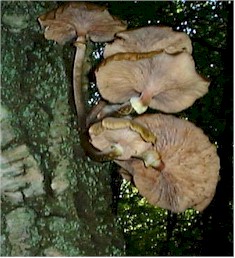 Common Name(s): Honey Fungus or
'Boot-Lace Fungus'.
Common Name(s): Honey Fungus or
'Boot-Lace Fungus'.| Honey Fungus |
 Common Name(s): Honey Fungus or
'Boot-Lace Fungus'.
Common Name(s): Honey Fungus or
'Boot-Lace Fungus'.
Scientific Name(s): Armillaria species
Type: Fungus.
Principle Host Trees & Shrubs:
Common on deciduous and coniferous trees. Will attack small shrubs and even gate posts!
Probably one of the most dangerous parasites, causing widespread loss of trees.
Description, Development & Diagnosis:
This fungus is parasitic, living within and feeding upon the wood of its host tree. It creates the fruiting bodies as part of its reproduction process. The fruiting bodies produce and release the fungal spores into the air which can then complete the reproductive cycle by infecting further trees. The decay process can cause death to the tree through damaged roots or through total structural failure.
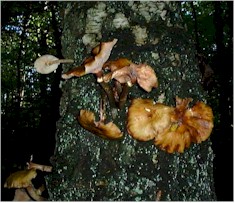 The
Honey Fungus mushrooms can be variable in size, colour and shape but are usually honey
coloured and growing in bunches. They appear annually, usually around the base of the tree
trunk in late summer - Autumn. The mushroom cap can be up to 150mm in diameter and most
species have a large ring located on the stalk. The fungus will not necessarily produce
mushrooms in all situations.
The
Honey Fungus mushrooms can be variable in size, colour and shape but are usually honey
coloured and growing in bunches. They appear annually, usually around the base of the tree
trunk in late summer - Autumn. The mushroom cap can be up to 150mm in diameter and most
species have a large ring located on the stalk. The fungus will not necessarily produce
mushrooms in all situations.
Honey Fungus usually produces a white mycelium sheet of fungal growth beneath the bark of a seriously infected tree.
Photographs top and right: Fungus growing on dead Birch, New Forest, England.These fruiting bodies were visible at heights of 20 feet!
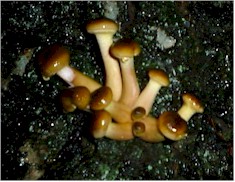
Photograph Right: Mushrooms just emerging on same tree.
Rhizomorphs
This fungus has the ability to produce structures called Rhizomorphs which resemble woody roots or boot laces. These structures can spread through the soil to infect other trees and stumps etc.
They also spread under the bark of infected trees. The photograph below shows the Honey Fungus Rhizomorphs under the bark of a felled Oak tree.
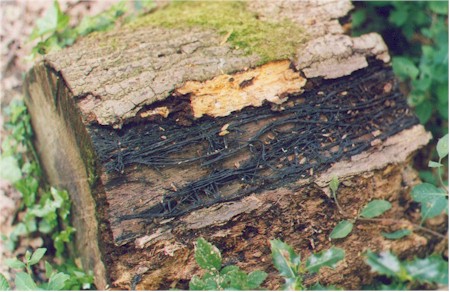
This photograph shows a close up of the Rhizomorph structure. They have a woody consistency and can be easily confused with twigs or thin roots.
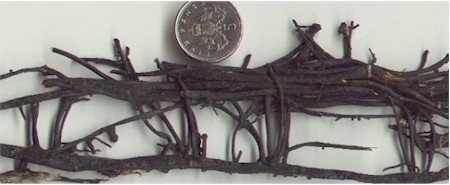
Significance & Control:
The fungus produces a serious white wood rot within its host. There is no viable control available. Infections should be inspected and monitored by an arboriculturist who can recommend any necessary action. Infected trees would normally be recommended for removal for safety reasons and to prevent the possibility of rhizomorphs spreading to other trees. It is essential to remove old stumps and fallen wood from important arboricultural areas threatened by the disease.
Honey Fungus is very common and has a necessary role within the woodland environment. However, in the garden and park it can be a serious problem. In some situations it may be possible to protect trees with a sunken barrier to help prevent the spreading rhizomorphs from reaching important trees. However, this may prove impractical in the long run. Another method is to regularly dig over an area of soil between the suspected source and vulnerable target tree in an attempt to break up the spreading rhizomorphs.
Resistant Species:
Box Elder (Acer negundo), Yew (Taxus baccata) and Californian Black Walnut (Juglans hindsii) are considered to be virtually immune from Honey Fungus attack. All other species should be considered as susceptible to attack.
Please Note: Many Fungi are toxic and individual reactions to them vary widely. Do not touch or eat fungi unless you have accurately identified them. Chris Skellern can not accept any legal responsibility or liability for errors in identification or for individual reactions to the consumption of fungi.
| Further Information. |
© 2001 Chris Skellern. AIE. Home | News | A-Z Index | Resources | Contact AIE | Terms of Use